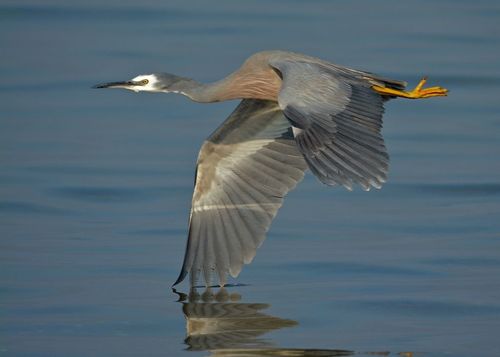
White-faced Heron
The White-faced Heron (*Egretta novaehollandiae*) is a common and widespread heron found throughout Australasia, including Australia, New Zealand, New Guinea, and parts of Indonesia. It is easily recognizable by its distinctive white face contrasting with its predominantly grey-blue plumage. This adaptable bird plays an important role in controlling populations of small aquatic and terrestrial animals, and is often seen foraging in shallow waters or damp grasslands. It has successfully colonized many areas, benefiting from the creation of artificial water bodies and pastures. While not considered globally threatened, it faces localized pressures from habitat loss and degradation.
60-70 cm
Length
90-110 cm
Wingspan
Least Concern
Conservation Status
Distribution
The White-faced Heron is primarily found in Australia, New Zealand, New Guinea, the Moluccas, and surrounding islands. It has also self-introduced to some Pacific islands, including Lord Howe Island and New Caledonia. Within Australia, it is widespread except for the most arid interior regions. It is found at various altitudes, from coastal areas to inland regions.
Lifespan
Unknown, but likely similar to other medium-sized herons (around 10-15 years in the wild).
White-faced Heron's Habitat
Habitat Types
Wetlands, Shallow freshwater and saltwater margins, Estuaries, Mangroves, Mudflats, Grasslands, Pastures, Agricultural lands, Artificial water bodies (dams, ponds)
Climate Zones
Tropical, Subtropical, Temperate
Adaptations
The White-faced Heron's long legs and neck are well-suited for wading in shallow water. Its sharp bill is ideal for spearing prey. Its generalist diet and tolerance of a wide range of habitats contribute to its adaptability.
Variations
While generally considered monotypic (no recognized subspecies), some minor regional variations in plumage and size may occur, but these are not formally classified.
Appearance
Breeding Plumage
Breeding birds may develop longer plumes on the head, back, and breast. The bare facial skin may also become more brightly colored during the breeding season.
Seasonal Feather Changes
Besides the breeding plumes, the plumage remains relatively consistent throughout the year.
Sex Based Plumage Differences
Males and females have very similar plumage.
Notable Features
Distinctive white face and forehead, Grey-blue body plumage, Long, slender neck, Sharp, pointed bill (yellowish-grey), Long, dark grey legs
Diet and Feeding
Primary Foods
Small fish, Crustaceans, Insects, Amphibians, Worms, Mollusks, Occasionally small reptiles and mammals
Foraging Behavior
The White-faced Heron typically forages by wading slowly in shallow water or walking on damp ground, patiently stalking prey. It may also stand still and wait for prey to approach. It uses its sharp bill to quickly stab and capture its food.
Specializations
Its long legs and neck allow it to forage in a variety of water depths, and its sharp bill is a versatile tool for catching different types of prey.
Seasonal Diet Variations
Diet may vary depending on prey availability, with a greater reliance on insects and other terrestrial invertebrates during drier periods when water levels are low.
Behavior
Social Structure
Generally solitary or found in pairs, but may form small loose flocks when foraging or roosting, especially outside the breeding season.
Communication
A harsh croaking call ('graaw') often given in flight or when disturbed, Soft crooning sounds during courtship, Bill-clapping during courtship displays
Migration
Mostly resident (non-migratory), but some local movements may occur in response to changing water levels or food availability. Some individuals may disperse widely after breeding.
Territorial or Group Behaviors
Defends breeding territories during the nesting season. Outside of breeding, they are generally less territorial but may defend feeding areas.
Conservation
Threats
Habitat loss and degradation (wetland drainage, conversion to agriculture), Pollution of waterways, Disturbance at nesting sites, Introduced predators (in some areas, e.g., feral cats)
Protection Programs
General protection of wetlands under various national and international agreements, Some specific conservation efforts focused on key breeding sites
Local National Laws
Protected under wildlife legislation in Australia and New Zealand.
Population Trend
Stable
Population Estimates
Not Evaluated, but considered common and widespread.
Interesting Facts
They are often seen foraging in urban areas.
This demonstrates their adaptability to human-modified landscapes.
They are known to use bait to attract fish.
While not as well-documented as in some other heron species, there are observations of White-faced Herons dropping small objects (e.g., insects, feathers) onto the water surface to lure fish.
They can sometimes be confused with other heron species.
Especially immature birds can resemble the smaller Striated Heron or the larger Eastern Great Egret, but the white face is usually a distinguishing feature.
Faqs about White-faced Heron
What is the difference between a White-faced Heron and a White-necked Heron?
The White-necked Heron (*Ardea pacifica*) is larger and has a completely white neck, lacking the grey-blue plumage on the body that is characteristic of the White-faced Heron.
Are White-faced Herons aggressive?
They can be territorial during the breeding season, but are generally not aggressive towards humans unless their nest is threatened.
Do White-faced Herons migrate?
They are mostly resident, but may undertake local movements in response to environmental conditions.
What do I do if I find an injured White-faced Heron?
Contact a local wildlife rescue organization or veterinarian. Do not attempt to handle the bird yourself without proper training, as they have sharp bills and can inflict injury.
Copyright @ Nature Style Limited. All Rights Reserved.
 English
English